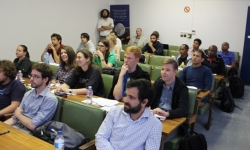CSIR and Stellenbosch University experts present first Antennas for Radio Telescopes course
In November 2016, seven industry leaders and 19 students from Europe and South Africa participated in a newly developed Antennas for Radio Telescopes course at Stellenbosch University. The course is part of the European School of Antennas’ offering for which the CSIR provided technical, organizational, and financial support. The purpose of the course is to provide broad and detailed insight into specific challenges facing antenna designers and others working in radio astronomy applications.
In November 2016, seven industry leaders and 19 students from Europe and South Africa participated in a newly developed Antennas for Radio Telescopes course at Stellenbosch University. The course is part of the European School of Antennas’ offering for which the CSIR provided technical, organizational, and financial support. The purpose of the course is to provide broad and detailed insight into specific challenges facing antenna designers and others working in radio astronomy applications.
South Africa has a track record in the field of antennas and propagation and is a key player in building the world’s largest and most sensitive radio telescope, the Square Kilometre Array (SKA). The SKA is currently being built in South Africa, which is also the host country. This serves as an opportunity to further develop the local capabilities in antennas for radio telescopes.
The course looks at specific antenna technologies used in modern instruments, from classical reflectors to a variety of array-based systems. Background on basic radio astronomical methods and performance metrics was provided, as well as an introduction to some basic calibration and imaging techniques.
Participants were given a spectrum of methods to design antennas, as well as an understanding of what is required from the antenna systems to yield the best possible instruments for different radio astronomy applications. Leading expert from Denmark, Dr Peter Meincke, says, “During the course, a day was reserved for reflector antennas, giving the students an opportunity to learn the fundamentals of design tasks, analysis methods, limitations and trade-off considerations.”
Participants were given a spectrum of methods to design antennas, as well as an understanding of what is required from the antenna systems to yield the best possible instruments for different radio astronomy applications. Leading expert from Denmark, Dr Peter Meincke, says, “During the course, a day was reserved for reflector antennas, giving the students an opportunity to learn the fundamentals of design tasks, analysis methods, limitations and trade-off considerations.”
Dr Albert Lysko of the CSIR Meraka Institute and Prof Dirk de Villiers of Stellenbosch University say that the course was an excellent opportunity to bring together the leading scientists working on antennas for radio telescopes and promote intercontinental cooperation and skill transfer to support the antenna field development and SKA initiative in South Africa and abroad.



